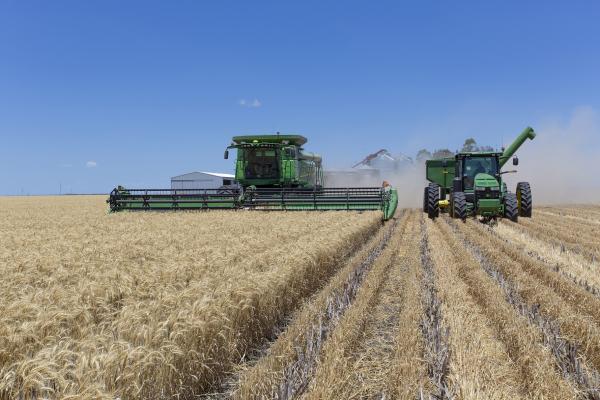
THE latest quarterly Rabobank Rural Confidence Survey has found that South Australian farmer confidence has soared to its highest levels in a decade – as late-season rains bolster prospects of above-average crops.
The turnaround in seasonal conditions – together with strong wheat, canola, lentil, lamb and beef prices – is set to boost farm incomes with 52pc of South Australian farmers surveyed expecting to generate a higher income in 2021-22, increasing to 82pc in the grains sector.
And this is set to boost investment right across the state’s agriculture sector, with close to a third of those South Australian farmers surveyed intending to increase investment in their farm businesses in the year ahead.
Increased investment is planned for on farm infrastructure, upgrading plant/machinery, the adoption of new technologies and increasing livestock numbers.
But it is the state’s grain growers who hold the strongest expansionary intentions, the survey found, with one-in-four looking to purchase additional property over the next 12 months.
The latest survey, released Tuesday, found 42pc of the state’s primary producers expect conditions in the agricultural economy to improve over the year ahead – almost double the 23pc holding that view three months ago.
Approximately 52pc expect similar conditions to last year, with just 2pc anticipating a deterioration.
This is the highest level of rural confidence reported in the state since March 2011.
Rabobank regional manager for South Australia, Roger Matthews, said good general rain which had fallen across the state from late June had fuelled much of the upswing in sentiment, as it marked a “significant departure from the past three years where seasonal conditions have been patchy”.
This was reflected in the survey results, with 77pc of those with an optimistic outlook, about the upcoming 12 months, citing seasonal conditions as the reason for their positive view – this was up from 31 per cent in the June quarter.
Commodity prices were also a factor underpinning the positive outlook, nominated as a reason for optimism by 70 per cent of those surveyed.
After a very dry summer and autumn period and plenty of dry sowing undertaken, Mr Matthews said the winter-rains provided “a lot of catch-up”.
Mr Matthews believes there’s now potential for an above-average crop, albeit dependent on seasonal conditions through spring.
“September is critical to the outlook, as the crops mature and require ongoing rain to bring them home and reduce the prevalence of frost,” he said.
Mr Matthews said early-season projections by the Department of Primary Industries and Regions had pegged the South Australian winter crop at 7.6 million tonnes, the second-largest harvest in five years.
This has buoyed confidence in the grains sector, with 69pc of surveyed grain growers in South Australia expecting improved business conditions in the year ahead – up from 19pc last quarter.
“The combination of good seasonal conditions and prices is expected to flow into good returns, particularly if spring rains deliver decent yields,” Mr Matthews said.
“With the wheat price still around $300 and lentils above $1000 per tonne, it will set many up with 82pc of grain growers expecting to generate a higher income in 2021-22 according to the survey.”
While grain grower sentiment outstripped the other surveyed commodity sectors in the state, Mr Matthews said confidence remained strong among beef producers; with 56pc expecting business conditions to improve (up from 46pc last survey), and the majority of sheep producers expecting either a continuation of current conditions (67pc) or an improvement (27pc).
“It is largely a price story, with record beef prices and the combination of high sheep and improving wool prices driving the positive outlook for 82pc and 88pc of beef and sheep producers, respectively,” he said.
Mr Matthews said a key challenge overhanging the otherwise positive outlook for the state’s agriculture sector was the availability of labour, particularly in the horticulture sector.
“The federal government’s recent announcement of the Ag Visa is a welcome step as it is something the industry has pushed for and recognises the importance of agriculture to the economy,” he said.
But any concerns around the availability of labour have done little to dampen investment
plans within the sector.
Around 29pc of South Australian farmers are looking to increase investment over the next 12 months, with a further 65pc intending to maintain investment at current levels.
The survey found grain growers held the strongest investment plans, with 48pc planning to increase investment.
Of these growers, around 53pc were looking to purchase more property Mr Matthews said.
“The strong appetite amongst ag businesses to expand their enterprises – underpinned by healthy balance sheets – has driven much of the upswing in property prices,” he said.
“And it is the combination of these rapidly-appreciating land values, low interest rates, good seasonal conditions and strong – and in some cases record – commodity prices that have all aligned for the first time in many people’s lifetimes.”
The Rabobank Rural Confidence Survey questions an average of 1000 primary producers across a wide range of commodities and geographical areas throughout Australia on a quarterly basis – conducted since 2000 by an independent research organisation.
The next results are scheduled for release in December 2021.







